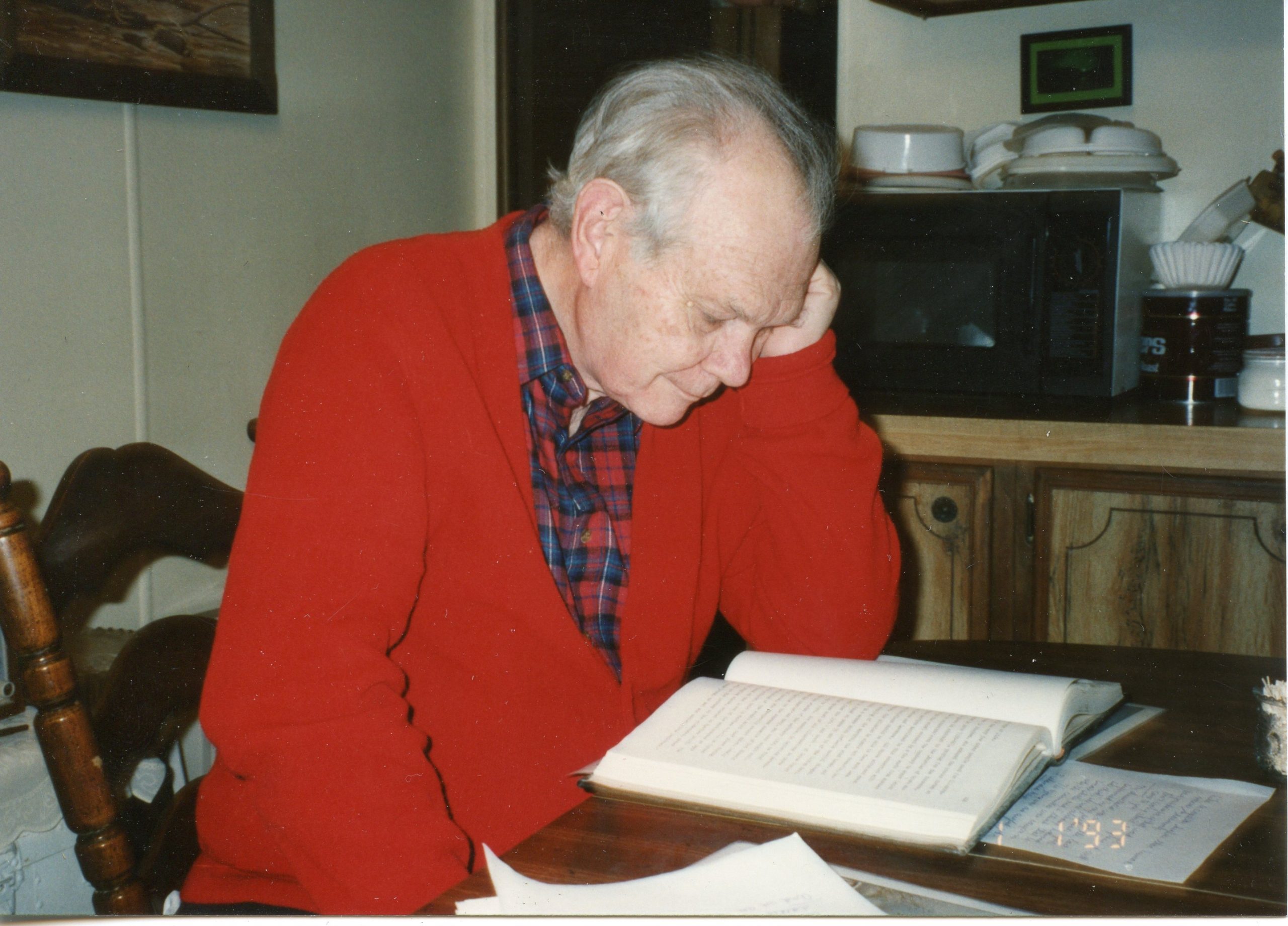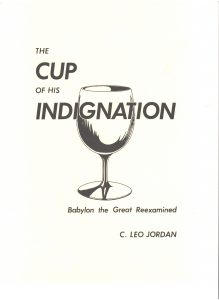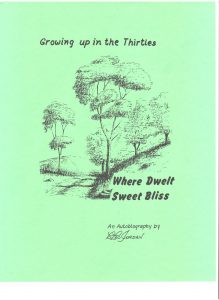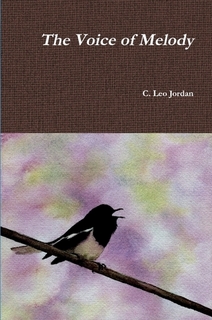Books by C. Leo Jordan
The covers for all but the Voice of Melody are original artwork by the author
Books
The Cup of His Indignation
The Seven Angels of the Apocalypse
The Voice of Melody (published posthumously)
Where Dwelt Sweet Bliss Part I (an autobiography—childhood)
Where Dwelt Sweet Bliss Part II (an autobiography—adulthood)
I remember well my father, Leo Jordan, typing away on a manual typewriter that he had set up in our dining room in Kingsport, Tennessee. I was around 13 or 14 years old. Dad thought that fellow church leaders (The United Pentecostal Church leaders, to be specific) would be excited to hear his latest insights into the scriptures. They weren't. (Read the complete story on the "About Leo" page).
Had the Internet been available then, Mr. Jordan would have found many like-minder people all over the world. As it were, we lived in a "hot-bed" of dispensationalists. Even so, God was gracious in that he occasionally, without warning, would send someone to our doorstep, from other parts of the globe who would have a word of encouragement for Leo. Other times, through word of mouth, he would get correspondence from fellow Christians, who also, gave him much needed affirmation that he was on the right track. So he kept typing and he kept teaching. The interesting thing is, though the church leaders rejected him, his fellow brothers and sisters in the Lord did not. Our living room often had the brethren sitting at Dad's feet, so to speak, way into the night. I listened through my bedroom wall.
Dad attempted to self-publish a couple of times but the results were not acceptable. More than once I heard him say, "I'm going to lay these works on the book shelf. If God wants them out, He will make a way." Well, I picked up the challenge by placing his works here and also by publishing his most glorious work, "The Voice of Melody" (available on Amazon).

An Oratorio for Zion. The Holy City. The New Jerusalem. Heaven. Does John's language regarding The New Jerusalem in his Revelation describe a literal place, the home of the redeemed, or is it figurative for something else, a spiritual entity which is quite incapable of being seen with mortal eye?
The author compares John's apocalyptic vision of the New Jerusalem, with similar Old Testament passages regarding Zion, especially in Isaiah and The Song of Solomon.
Sometimes this entity is metaphorically described as a city, sometimes as a bride or even a garden.
This book examines the relationship between Zion and Christ, the bride and the bridegroom, and the garden and gardener.
Jordan discovered that all the prophecy, however, is primarily about Jesus Christ. And that ultimately Christ died to save sinners.
"Surely, it is with 'the voice of melody' that his servants declare the good news unto all people."
The Cup of His Indignation Babylon the Great Reexamined (Coming Soon)
THE PRESENT VOLUME REPRESENTS a complete rewrite of a manuscript by the same name that was prepared in 1977. Though that manuscript was never published, something like a hundred copies were circulated to interested parties. Since then, the subject has continued to grow, and not being totally satisfied with the original presentation, I decided to revise it. New material has been included that previously appeared only as essays on various topics concerning Babylon the Great. The result is that the present work is well over twice as long as the original.
My interest in the subject of Babylon the Great came about when I began a serious program of Biblical study in the early seventies. My intention was to establish on a more certain Scriptural foundation the assertions of Protestantism that the Roman Catholic Church is represented by Babylon the Great. Though I was in agreement, I did not think we had sufficient scriptural justification for that claim. Not only could I not find support, but, to my surprise, I found the Bible pointing in an entirely different direction.
Another factor entered the picture. I was raised in a dispensationally oriented church and was taught, and believed, dispensational doctrines of eschatology. It wasn't long after my serious study began that I saw dispensationalism was in error. Therefore, the present work illustrates to a degree my efforts to untangle myself from that erroneous system of theology.
But more important than these considerations is the realization that soon came to me: the Bible is indeed an inspired book; though written by many it was at the instigation of One, the Holy Spirit. I had rashly claimed, in a moment of despair, that there was more inspiration to be found in a good mathematics treatise than in the Bible. I was soon made to see otherwise, and the opening of my understanding led me to discover several important corollaries to this belief. For example, the Bible asks no questions that it does not answer. Its symbolism and figurative speech is consistent throughout: symbols are defined and retain their meaning in every book. (I realize that because of slightly faulty translations this cannot always be shown, but enough times have I seen it to prevail that I take it as axiomatic.) The total result was the discovery that the Bible is a wonderful harmony of concepts, far beyond what mortal minds unaided by the Spirit could have conceived.


The Seven Angels of the Apocalypse (A midrash for Israel) (Coming Soon)
Introduction to the Seven Angels of the Apocalypse
Nowhere in the Sacred Literature are the angels featured as prominently as they are in the Apocalypse of St. John. The book could be subtitled “the Acts of the Angels.” From John’s opening salutation through his closing farewell, the words and actions of angel’s form its theme. Although an innumerable company of these celestial beings are seen, the principal action revolve about seven chief angels who are portrayed as the mighty executors of God’s wrath on a wicked generation.
Jewish rabbinic tradition postulated seven chief angels: Michael, Gabriel, Raphael, Uriel, Jophiel, Zadkiel, and Chamiel. The ancient sect of Qumran, the authors of the Dead Sea scrolls, also believed there were seven chief angels. One of the manuscripts contains an elaborate account of the final war between the powers of light under the leadership of these seven and the powers of darkness under the leadership of Satan.
However, through the Bible, it appears that the angels were reluctant to reveal their names: Gabriel alone identifies himself, and, even so, “Gabriel” is interpreted simply as “man of God.” Michael is mentioned by name five times: thrice in Daniel, once in Jude, and once in the Apocalypse. Jude calls him an archangel, that is, chief angel. John describes him as the leader in the battle against Satan. In Daniel he is called “one of the chief princes,” implying the existence of more than one such archangel. . . .
Where Dwelt Sweet Bliss (an Autobiography) Growing up in the Thirties (Part I: Childhood and Part II (Adulthood)
INDIANA BOYHOOD
by C. L. Jordan
Once I knew where dwelt sweet bliss,
Where violets gleam
Beside a stream
In fragile mounds of amethyst.
Perhaps it was a dream.
In meadow bright or dusky glade
Dwelt purest joy
Without alloy.
It lingered in sunlight and shade__
And in a dreaming boy.
All vanished now, that merry spell,
And lost the song,
That artless song,
Learned in some forgotten dell
And sung the whole day long.
Yes, lost forever that simple faith
And happy theme.
For I deem
It was but an empty wraith__
Nothing but a dream.

